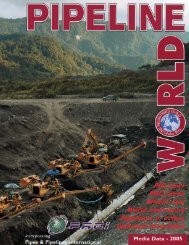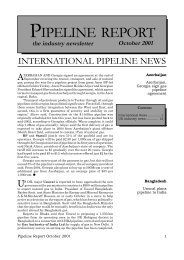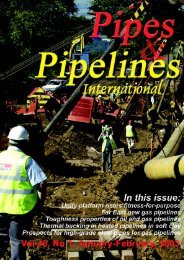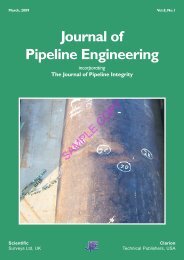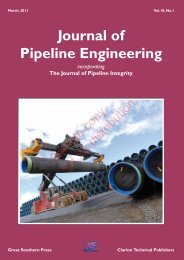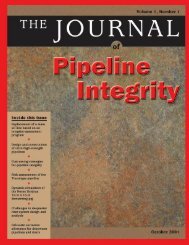JPE - Sept09 - cover2-4.pmd - Pipes & Pipelines International ...
JPE - Sept09 - cover2-4.pmd - Pipes & Pipelines International ...
JPE - Sept09 - cover2-4.pmd - Pipes & Pipelines International ...
You also want an ePaper? Increase the reach of your titles
YUMPU automatically turns print PDFs into web optimized ePapers that Google loves.
178<br />
Camisea system, including the subcritical, stable behaviour<br />
prior to unstable fracture or plastic collapse.<br />
In order to quantify the impact of ground movement,<br />
fracture mechanics was used to relate an assumed defect<br />
size to the failure load and to gain some insight into how<br />
quickly tearing can occur. To assess the soil loading and<br />
observed crack growth behaviour, an elastic-plastic fracture<br />
analysis was conducted for the tearing process that led to<br />
the fifth spill incident at KP 125+950, where a<br />
circumferential crack initiated on the outside of the pipe<br />
and grew by progressive tearing to a through-wall 275-mm<br />
long circumferential crack; Fig.2 shows the failed pipe<br />
segment after complete rupture of this crack. The fracture<br />
surface of the crack has three distinct stages of crack<br />
propagation, which are shown in Fig.3; in the figure, the<br />
top is the outside wall of the pipe and the blue arrows<br />
marking the transition between stages.<br />
In this spill incident, the mechanism of both crack initiation<br />
and propagation was ductile tearing caused by soil<br />
movement. It should be noted that under high axial loads,<br />
the biaxial stress state of the pipe could effectively increase<br />
the axial load needed to cause general yielding and allow<br />
tearing of the weld material prior to the general yielding of<br />
the pipe. After this ductile tearing through the majority of<br />
the pipe wall, the final slant fracture occurred by plastic<br />
collapse of the remaining ligament. The difference in the<br />
fracture surface in the three stages of crack growth shown<br />
in Fig.3 may be due to the differences in the rate of ductile<br />
tearing.<br />
In ductile materials, plastic tearing ahead of a crack initiates<br />
when the driving force of the crack, J, reaches J IC . However,<br />
once tearing begins there can be stable crack advance due<br />
to the increasing resistance of the material to crack advance,<br />
The Journal of Pipeline Engineering<br />
which is typically summarized with a J-R curve. A J-R curve<br />
for API 5L X70 steel is shown in Fig.4 [7].<br />
As can be seen in Fig.4, as the length of the crack, Da,<br />
increases, the driving force required for further crack<br />
advance increases. Unstable fracture will occur when the<br />
rate of change of the crack driving force with crack length<br />
becomes greater than the rate of change of the resistance<br />
curve with crack length for a given loading or the remaining<br />
ligament fails by plastic collapse: for API 5L X70, J is IC<br />
reported to be approx. 400 kJ/m2 [7]. In the initial stages of<br />
crack growth, corresponding to the ductile tearing in stage<br />
one in Fig.3, the resistance curve is relatively steep. As the<br />
crack grows, however, the slope of the resistance curve<br />
decreases and it is possible that a transition to a more rapid<br />
ductile tearing begins when the crack reaches a length of<br />
1.4 mm, which corresponds to the blue arrow indicating<br />
the end of the first stage in Fig.3. This transition may<br />
correspond to this change in slope of the resistance curve<br />
seen in Fig.4. This more rapid ductile tearing continues<br />
until the rate of change of the crack driving force with crack<br />
length becomes greater than the rate of change of the<br />
resistance curve with crack length for a given loading or the<br />
remaining ligament fails by plastic collapse<br />
Sample issue<br />
Fig.4. J-R resistance curve for<br />
API 5L X70.<br />
The load necessary to reach a value of J IC = 400kJ/m 2 was<br />
computed using a SENT (single edge notch tension) with a<br />
crack of length a = 1.4mm. The stress in the wall was found<br />
to be approx. 95ksi, greater than the measured yield stress<br />
(82ksi) of the pipe material. This would be consistent with<br />
the observed plastic deformation and lateral contraction of<br />
the pipe. This wall stress correlates to a 1,205kip load in<br />
addition to the typical operating pressure of 2,320psi. It<br />
should be noted that the calculation of the load based on<br />
J is only approximate because J is very sensitive to the stress<br />
near J IC and tearing would probably occur before the



